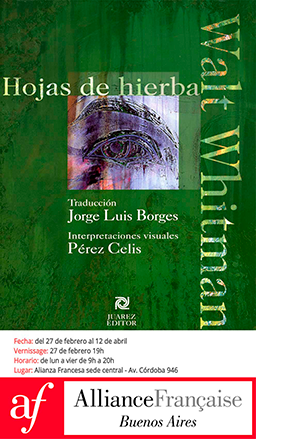THE FIRE KEEPERS, A PERSPECTIVE ON THE MYTH OF FIRE FROM A MEXICAN CURATORIAL PERSPECTIVE
In an art industry that increasingly advocates following the lines established by cultural policies, it is always comforting to return to thesis themes, to environments that draw from social and historiographic sources, of course, but also from myths and a well-understood anthropology. You can go deeper in subtitles and lines or you can put together a skeleton, but the overview can also be a reward these days.
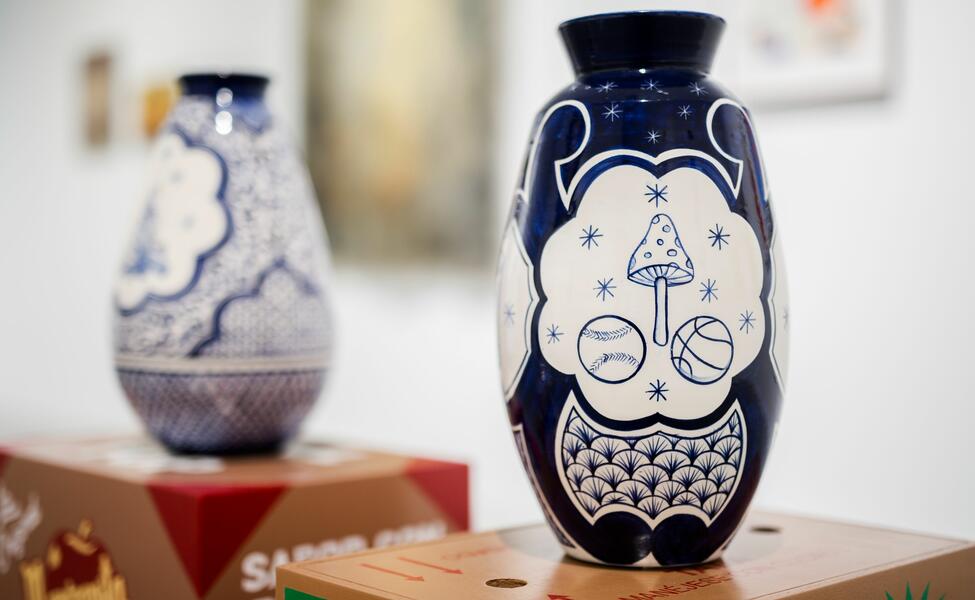
Curators Lorena Peña Brito (Mexico City, Mexico) and Eduardo Sarabia (Los Angeles, USA, 1976), who doubles for the occasion from his role as artist, have been in charge of giving form to the legends about the origin of fire, its meaning as creation and destruction and the multiple ways in which cultures have approached it. Within the broad imagery, the artists selected in the collective exhibition The Fire Keepers contribute their visions through different techniques, but also entering from different angles and proposals that help to trace synergies between these conceptions.
Although the initial intention of showing the approach and representation by various cultures could be somewhat blurred by the presence only of Mexican artists or those closely related to the country, the result is closer to having been achieved thanks, precisely, to the iconographic variety arranged in the room. Nevertheless, the cultural or anthropological approach can be found in this materialization, a sample of the intrinsic variety of an almost universal myth that has been varnished with a fierce mixture.
Spread out on the walls we can understand the importance of this myth and the representative versatility of its multiple forms, from the language of expressive intensity of the works on paper by Marcel Dzama (Winnipeg, Canada, 1974) to the oil paintings by Mariana Paniagua (Mexico City, Mexico, 1994), more focused on the monochromatic range of fire, identities that also monopolize the exhibited work of Julian Madero Islas (Mexico City, Mexico, 1990). The enormous proposal of Giovanni Fabián (Cherán, Mexico, 1993), representing the cosmological side of the element, or the syncretism of Alejandro García Contreras (Tapachula, Mexico, 1982) who, with his sculpture Pazuzu/María Magdalena manages to confront the myth narrated from mythology and religion, stand out for their expressiveness and impact.
Of course, there is room for other interpretations and techniques that allude to the adaptability of the legend, perfectly expressed in the urban and pop language of Christopher Myers (New York, USA, 1974), the circular arrangement in the wood of the Agüeros series by Circe Irasema (Mexico City, Mexico, 1987), or the distanced chromatism, although perceptible in the figurative, of the works of Lucía Vidales (Mexico City, Mexico, 1986), Felipe Baeza (Guanajuato, Mexico, 1987) or the filmmaker Pablo Aldrete (Guadalajara, Mexico, 1972).
Eduardo Sarabia's contribution, in addition to his own as curator, completes that plane of visions, adding ex profeso pieces, such as the acrylics on paper Fire Keepers or Fire Visions or his celebrated boxes and vases that, without having a perceptible element of union with the exhibition's theory, contribute a certain aesthetic element, perhaps as a reference to that same aesthetic that has taken hold of humanity since the discovery of fire or as guardians of it.
The Fire Keepers can be seen until November 8 at VETA by Fer Francés, Antoñita Jiménez, 37-43, Madrid (Spain).
May interest you
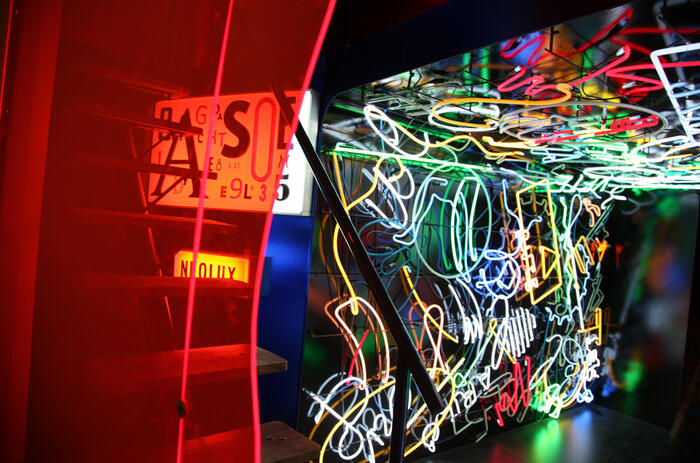
The Museo Moderno announced that La Menesunda, the legendary work by Marta Minujín and Rubén Santantonín –a work originally created in 1965, reconstructed by the Museo de Arte Moderno de Buenos Aires and inaugurated in 2015 and later in 2019 at the New Museum in New York– is on view for the first time in Europe as part of a tour that will show it in four countries.
THE EUROPEAN TOUR OF 'LA MENESUNDA' ACCORDING TO MARTA MINUJÍN
The Museo Moderno announced that La Menesunda, the legendary work by Marta Minujín and Rubén Santantonín –a work originally created in 1965, reconstructed by the Museo de Arte Moderno de Buenos Aires and inaugurated in 2015 and later in 2019 at the New Museum in New York– is on view for the first time in Europe as part of a tour that will show it in four countries.

The Museo Moderno announced that La Menesunda, the legendary work by Marta Minujín and Rubén Santantonín –a work originally created in 1965, reconstructed by the Museo de Arte Moderno de Buenos Aires and inaugurated in 2015 and later in 2019 at the New Museum in New York– is on view for the first time in Europe as part of a tour that will show it in four countries.
THE EUROPEAN TOUR OF 'LA MENESUNDA' ACCORDING TO MARTA MINUJÍN
The Museo Moderno announced that La Menesunda, the legendary work by Marta Minujín and Rubén Santantonín –a work originally created in 1965, reconstructed by the Museo de Arte Moderno de Buenos Aires and inaugurated in 2015 and later in 2019 at the New Museum in New York– is on view for the first time in Europe as part of a tour that will show it in four countries.
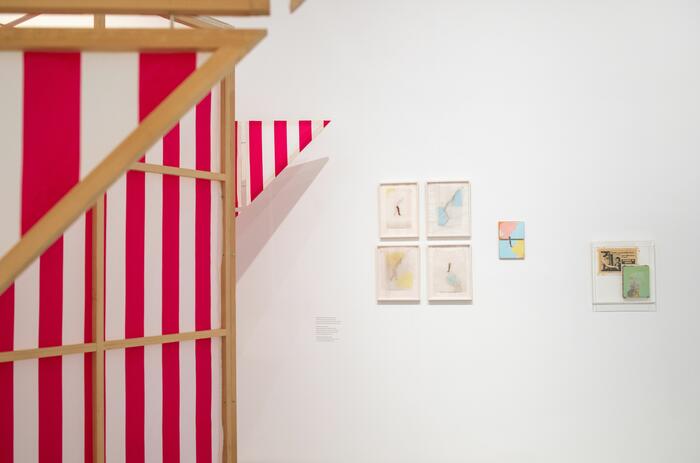
“I imagine the museum as an archipelago. It is not a continent, but an archipelago (...) The idea today is to put the world in contact with the world, to put some parts of the world in contact with other parts of the world... We must multiply the number of worlds inside museums”. Édouard Glissant (Sainte-Marie, Martinique, 1929-Paris, France, 2011) expressed his vision of museum functionality in this metaphorical way in his work Poetics of Relationship (1990).
CAN THE ARCHIPELAGO ENTER THE MUSEUM? IBEROAMERICA IN THE PROPOSAL OF THE HELGA DE ALVEAR MUSEUM
“I imagine the museum as an archipelago. It is not a continent, but an archipelago (...) The idea today is to put the world in contact with the world, to put some parts of the world in contact with other parts of the world... We must multiply the number of worlds inside museums”. Édouard Glissant (Sainte-Marie, Martinique, 1929-Paris, France, 2011) expressed his vision of museum functionality in this metaphorical way in his work Poetics of Relationship (1990).
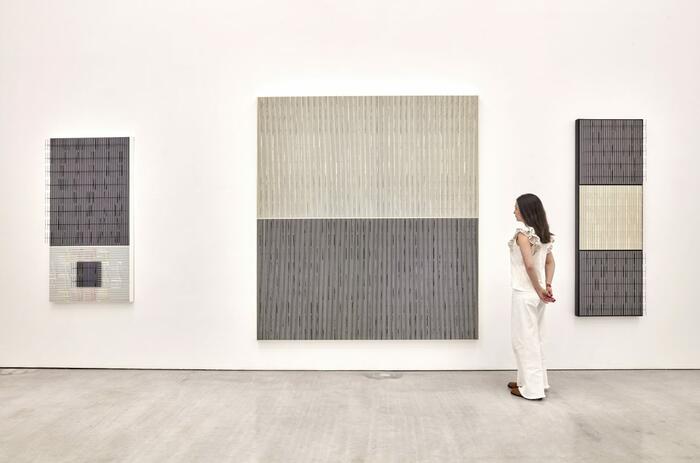
Jesús Rafael Soto (Ciudad Bolívar, Venezuela, 1923-Paris, France, 2005) carried out several investigations during the 1960s on possible solutions to face the fragmentation that his language needed. From those explorations emerged the T, a fine, metallic element of simple purity that allowed him to access, with satisfaction, to that disintegration he pursued and to reach a certain sensation of vibration and sublime volatility thanks to the linear disposition of these elements and their uniform arrangement that ended up giving the work a certain mediation between the spectator and the space and movement.
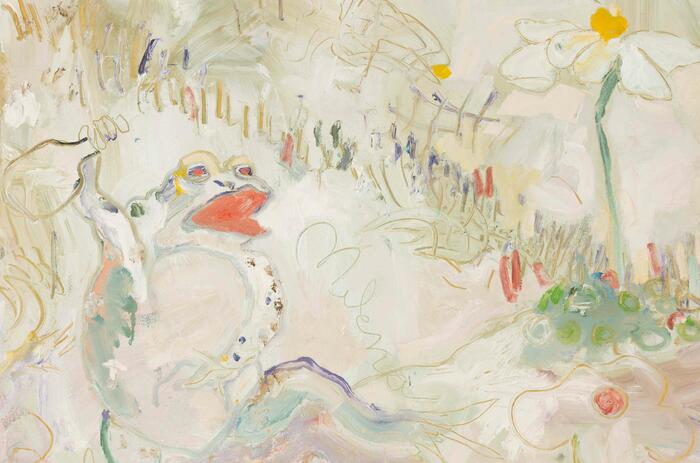
Travesía Cuatro hosts at its Madrid headquarters Surf and Turf, the fifth exhibition that the gallery dedicates to Milena Múzquiz (Tijuana, Mexico, 1972), that gathers, with about thirty works, the continuity of the production that began after the aesthetic and technical change produced by the end of Los Súper Elegantes, a musical group that he shared with the Argentine Martiniano López Crozet, and which represented a platform that brought together his purest expression through voice and body, as well as with the aesthetic possibilities of costumes and image.
THE DAILY LIFE AND POPULAR EXPRESSION OF MILENA MÚZQUIZ IN TRAVESÍA CUATRO
Travesía Cuatro hosts at its Madrid headquarters Surf and Turf, the fifth exhibition that the gallery dedicates to Milena Múzquiz (Tijuana, Mexico, 1972), that gathers, with about thirty works, the continuity of the production that began after the aesthetic and technical change produced by the end of Los Súper Elegantes, a musical group that he shared with the Argentine Martiniano López Crozet, and which represented a platform that brought together his purest expression through voice and body, as well as with the aesthetic possibilities of costumes and image.
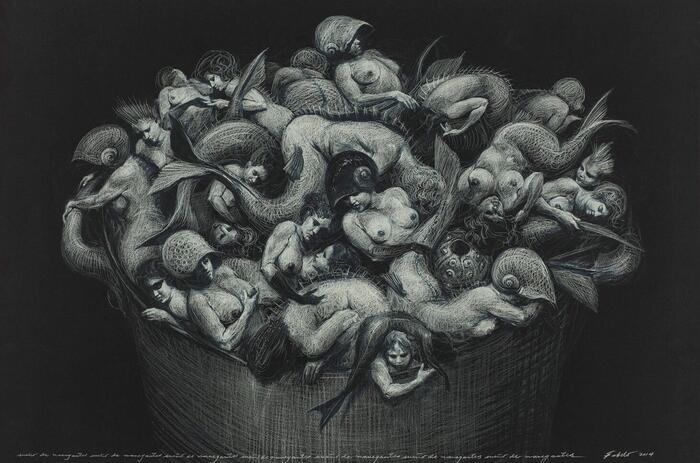
The DA2 hosts the last stage of the itinerancy of the Luciano Méndez Sánchez Contemporary Cuban Art Collection, a cycle of exhibitions that the collection started in 2019 in Spain in this institution and that reflects, through different curatorial lines, the realities and attitudes around contemporary art in Cuba.
THE LATEST TOUR AT DA2 OF THE LUCIANO MÉNDEZ SÁNCHEZ CONTEMPORARY CUBAN ART COLLECTION
The DA2 hosts the last stage of the itinerancy of the Luciano Méndez Sánchez Contemporary Cuban Art Collection, a cycle of exhibitions that the collection started in 2019 in Spain in this institution and that reflects, through different curatorial lines, the realities and attitudes around contemporary art in Cuba.
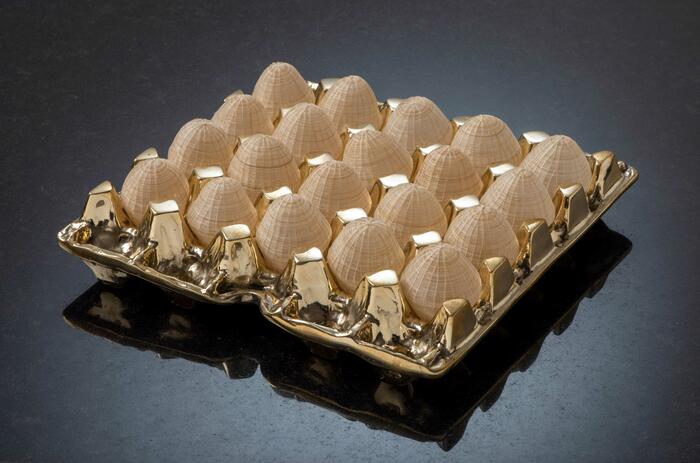
Rutas relacionales (Relational Routes) is the long-term collective with which the Lucía Mendoza gallery celebrates its tenth anniversary and with which it intends to raise awareness, through the work of about 40 artists, about several of the current thematic and philosophical axes, those that trace their need from the relationship of mankind with its environment. In these axes, we find lines of argument that deal with ecology, society and economies, passing through everything that composes them, such as political processes or the construction of identity.
"RELATIONAL ROUTES": THE LATIN AMERICAN COLLECTIVE EXHIBITION AT LUCÍA MENDOZA
Rutas relacionales (Relational Routes) is the long-term collective with which the Lucía Mendoza gallery celebrates its tenth anniversary and with which it intends to raise awareness, through the work of about 40 artists, about several of the current thematic and philosophical axes, those that trace their need from the relationship of mankind with its environment. In these axes, we find lines of argument that deal with ecology, society and economies, passing through everything that composes them, such as political processes or the construction of identity.
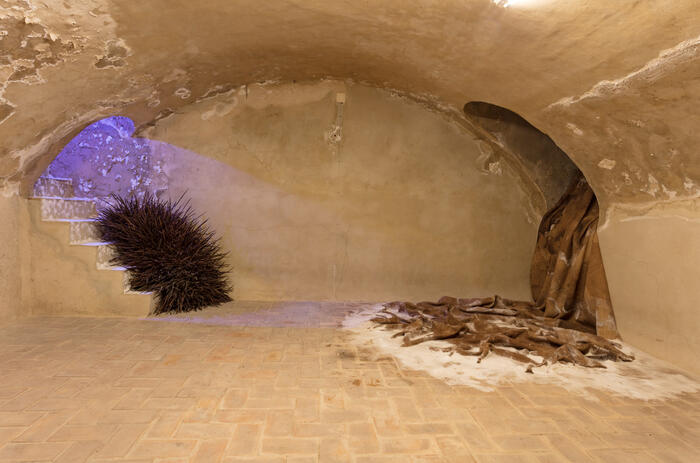
The Andalusian Center for Contemporary Art (CAAC) is showing Continuum or the appearance of the parts and the whole in its recovered space in the cellars of the institution's complex in Seville, an exhibition whose origin is to be sought in Profundis, the proposal that Colombian Delcy Morelos (Tierralta, Colombia, 1967) made for this same center this year and that served as a framework to sublimate, from the analysis, the dialogue beyond the material and the relationship she kept with her collaborators when it came to putting together her recent exhibition.
CONTINUUM: FROM THE DIALOGUE WITH DELCY MORELOS
The Andalusian Center for Contemporary Art (CAAC) is showing Continuum or the appearance of the parts and the whole in its recovered space in the cellars of the institution's complex in Seville, an exhibition whose origin is to be sought in Profundis, the proposal that Colombian Delcy Morelos (Tierralta, Colombia, 1967) made for this same center this year and that served as a framework to sublimate, from the analysis, the dialogue beyond the material and the relationship she kept with her collaborators when it came to putting together her recent exhibition.
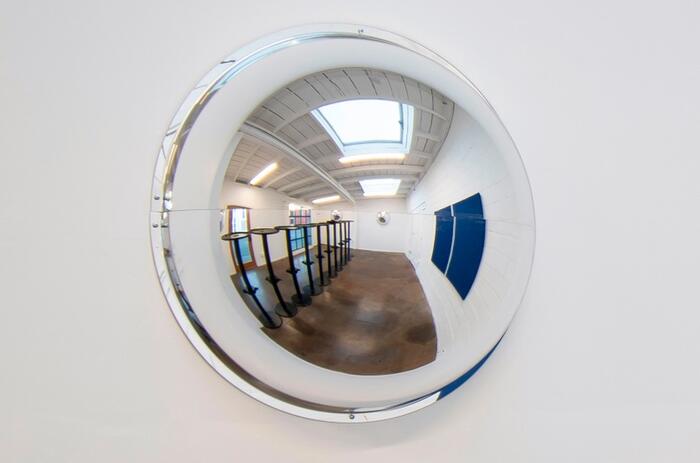
Liberty & Security is the exhibition at Jumex by Débora Delmar (Mexico 1986) in which she delves into the effects of globalization on everyday life, based on a critique of privatization and the homogenization of public space. The artist investigates the physical and symbolic impacts of architecture present in gentrification, consumism and surveillance in the urban environment.
DÉBORA DELMAR ON GENTRIFICATION AND ARCHITECTURE
Liberty & Security is the exhibition at Jumex by Débora Delmar (Mexico 1986) in which she delves into the effects of globalization on everyday life, based on a critique of privatization and the homogenization of public space. The artist investigates the physical and symbolic impacts of architecture present in gentrification, consumism and surveillance in the urban environment.
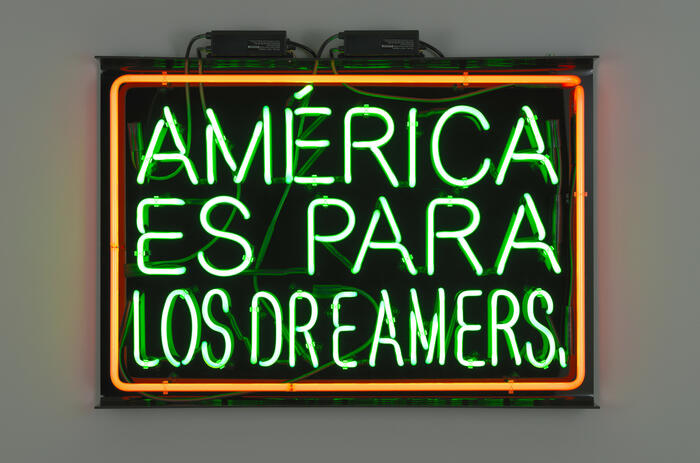
Shifting Landscapes is a group exhibition at the Whitney Museum that explores how constantly evolving political, ecological, and social landscapes inspire artists and their interpretations of the world around them.
AN EXHIBITION AT THE WHITNEY MUSEUM ADDRESSING POLITICAL, ECOLOGICAL, AND SOCIAL CHANGE
Shifting Landscapes is a group exhibition at the Whitney Museum that explores how constantly evolving political, ecological, and social landscapes inspire artists and their interpretations of the world around them.
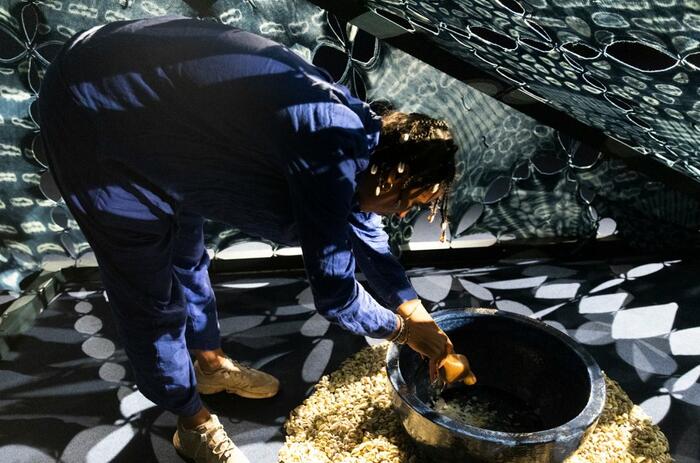
Nebulosa de la calabaza is the title of the first solo exhibition presented in Spain by Tabita Rezaire (Paris, France, 1989), an artist living in French Guiana. Renowned for her use of new media and multidisciplinarity to explore the relationship between contemporary worlds transited from technology and their relationship with the most ancestral and spiritual environment, the Guyanese-heritage artist focuses her production on activism from the perspective of denunciation from feminism and decolonization as key points.
DENOUNCEMENT AND ORIGIN IN TABITA REZAIRE
Nebulosa de la calabaza is the title of the first solo exhibition presented in Spain by Tabita Rezaire (Paris, France, 1989), an artist living in French Guiana. Renowned for her use of new media and multidisciplinarity to explore the relationship between contemporary worlds transited from technology and their relationship with the most ancestral and spiritual environment, the Guyanese-heritage artist focuses her production on activism from the perspective of denunciation from feminism and decolonization as key points.
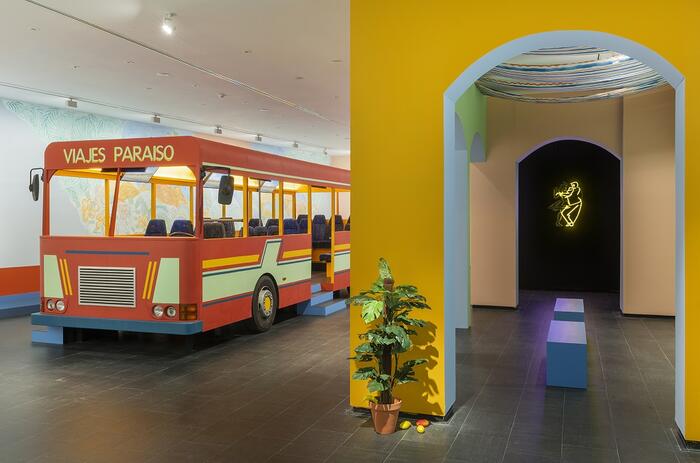
Sol Calero (Caracas, Venezuela, 1982) uses the guanabana, a fruit endemic to Central America and the Caribbean, to symbolically instrumentalize the creation of a representation of the feelings of belonging, home, everyday life and stereotypes through the wide conquest of the spaces of the Museo Centro de Arte Dos de Mayo, transformed for the occasion into visual and popular references of a well-known and recognized Latin America.
IDENTITY AND HOME – ACCORDING TO SOL CALERO IN THE CA2M MUSEUM
Sol Calero (Caracas, Venezuela, 1982) uses the guanabana, a fruit endemic to Central America and the Caribbean, to symbolically instrumentalize the creation of a representation of the feelings of belonging, home, everyday life and stereotypes through the wide conquest of the spaces of the Museo Centro de Arte Dos de Mayo, transformed for the occasion into visual and popular references of a well-known and recognized Latin America.
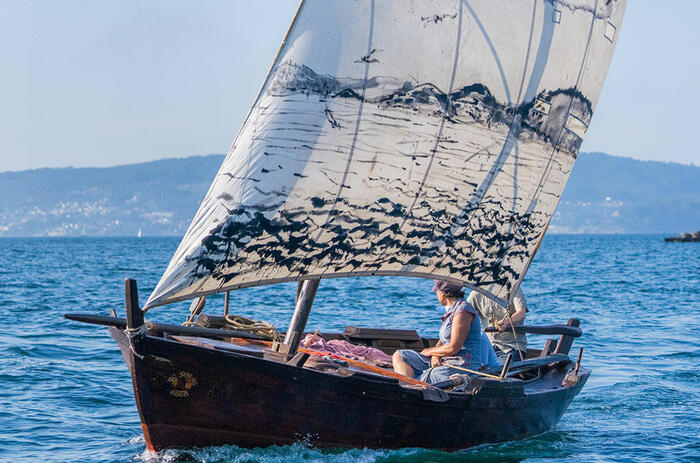
The Museum of Pontevedra exhibits Vento (wind, in Galician), the proposal that the artist Alberto Baraya (Bogota, Colombia, 1968) has developed and now shows at its headquarters in the Castelao Building as part of the cycle of exhibitions Infiltracións. This program aims to carry out specific projects that have as their backbone the dialogue arising from research and work with pieces from the collection of the Galician institution to promote re-readings on it.
VENTO BY ALBERTO BARAYA – IN PONTEVEDRA
The Museum of Pontevedra exhibits Vento (wind, in Galician), the proposal that the artist Alberto Baraya (Bogota, Colombia, 1968) has developed and now shows at its headquarters in the Castelao Building as part of the cycle of exhibitions Infiltracións. This program aims to carry out specific projects that have as their backbone the dialogue arising from research and work with pieces from the collection of the Galician institution to promote re-readings on it.

The Museo Moderno announced that La Menesunda, the legendary work by Marta Minujín and Rubén Santantonín –a work originally created in 1965, reconstructed by the Museo de Arte Moderno de Buenos Aires and inaugurated in 2015 and later in 2019 at the New Museum in New York– is on view for the first time in Europe as part of a tour that will show it in four countries.
THE EUROPEAN TOUR OF 'LA MENESUNDA' ACCORDING TO MARTA MINUJÍN
The Museo Moderno announced that La Menesunda, the legendary work by Marta Minujín and Rubén Santantonín –a work originally created in 1965, reconstructed by the Museo de Arte Moderno de Buenos Aires and inaugurated in 2015 and later in 2019 at the New Museum in New York– is on view for the first time in Europe as part of a tour that will show it in four countries.

“I imagine the museum as an archipelago. It is not a continent, but an archipelago (...) The idea today is to put the world in contact with the world, to put some parts of the world in contact with other parts of the world... We must multiply the number of worlds inside museums”. Édouard Glissant (Sainte-Marie, Martinique, 1929-Paris, France, 2011) expressed his vision of museum functionality in this metaphorical way in his work Poetics of Relationship (1990).
CAN THE ARCHIPELAGO ENTER THE MUSEUM? IBEROAMERICA IN THE PROPOSAL OF THE HELGA DE ALVEAR MUSEUM
“I imagine the museum as an archipelago. It is not a continent, but an archipelago (...) The idea today is to put the world in contact with the world, to put some parts of the world in contact with other parts of the world... We must multiply the number of worlds inside museums”. Édouard Glissant (Sainte-Marie, Martinique, 1929-Paris, France, 2011) expressed his vision of museum functionality in this metaphorical way in his work Poetics of Relationship (1990).

Jesús Rafael Soto (Ciudad Bolívar, Venezuela, 1923-Paris, France, 2005) carried out several investigations during the 1960s on possible solutions to face the fragmentation that his language needed. From those explorations emerged the T, a fine, metallic element of simple purity that allowed him to access, with satisfaction, to that disintegration he pursued and to reach a certain sensation of vibration and sublime volatility thanks to the linear disposition of these elements and their uniform arrangement that ended up giving the work a certain mediation between the spectator and the space and movement.

Travesía Cuatro hosts at its Madrid headquarters Surf and Turf, the fifth exhibition that the gallery dedicates to Milena Múzquiz (Tijuana, Mexico, 1972), that gathers, with about thirty works, the continuity of the production that began after the aesthetic and technical change produced by the end of Los Súper Elegantes, a musical group that he shared with the Argentine Martiniano López Crozet, and which represented a platform that brought together his purest expression through voice and body, as well as with the aesthetic possibilities of costumes and image.
THE DAILY LIFE AND POPULAR EXPRESSION OF MILENA MÚZQUIZ IN TRAVESÍA CUATRO
Travesía Cuatro hosts at its Madrid headquarters Surf and Turf, the fifth exhibition that the gallery dedicates to Milena Múzquiz (Tijuana, Mexico, 1972), that gathers, with about thirty works, the continuity of the production that began after the aesthetic and technical change produced by the end of Los Súper Elegantes, a musical group that he shared with the Argentine Martiniano López Crozet, and which represented a platform that brought together his purest expression through voice and body, as well as with the aesthetic possibilities of costumes and image.

The DA2 hosts the last stage of the itinerancy of the Luciano Méndez Sánchez Contemporary Cuban Art Collection, a cycle of exhibitions that the collection started in 2019 in Spain in this institution and that reflects, through different curatorial lines, the realities and attitudes around contemporary art in Cuba.
THE LATEST TOUR AT DA2 OF THE LUCIANO MÉNDEZ SÁNCHEZ CONTEMPORARY CUBAN ART COLLECTION
The DA2 hosts the last stage of the itinerancy of the Luciano Méndez Sánchez Contemporary Cuban Art Collection, a cycle of exhibitions that the collection started in 2019 in Spain in this institution and that reflects, through different curatorial lines, the realities and attitudes around contemporary art in Cuba.

Rutas relacionales (Relational Routes) is the long-term collective with which the Lucía Mendoza gallery celebrates its tenth anniversary and with which it intends to raise awareness, through the work of about 40 artists, about several of the current thematic and philosophical axes, those that trace their need from the relationship of mankind with its environment. In these axes, we find lines of argument that deal with ecology, society and economies, passing through everything that composes them, such as political processes or the construction of identity.
"RELATIONAL ROUTES": THE LATIN AMERICAN COLLECTIVE EXHIBITION AT LUCÍA MENDOZA
Rutas relacionales (Relational Routes) is the long-term collective with which the Lucía Mendoza gallery celebrates its tenth anniversary and with which it intends to raise awareness, through the work of about 40 artists, about several of the current thematic and philosophical axes, those that trace their need from the relationship of mankind with its environment. In these axes, we find lines of argument that deal with ecology, society and economies, passing through everything that composes them, such as political processes or the construction of identity.

The Andalusian Center for Contemporary Art (CAAC) is showing Continuum or the appearance of the parts and the whole in its recovered space in the cellars of the institution's complex in Seville, an exhibition whose origin is to be sought in Profundis, the proposal that Colombian Delcy Morelos (Tierralta, Colombia, 1967) made for this same center this year and that served as a framework to sublimate, from the analysis, the dialogue beyond the material and the relationship she kept with her collaborators when it came to putting together her recent exhibition.
CONTINUUM: FROM THE DIALOGUE WITH DELCY MORELOS
The Andalusian Center for Contemporary Art (CAAC) is showing Continuum or the appearance of the parts and the whole in its recovered space in the cellars of the institution's complex in Seville, an exhibition whose origin is to be sought in Profundis, the proposal that Colombian Delcy Morelos (Tierralta, Colombia, 1967) made for this same center this year and that served as a framework to sublimate, from the analysis, the dialogue beyond the material and the relationship she kept with her collaborators when it came to putting together her recent exhibition.

Liberty & Security is the exhibition at Jumex by Débora Delmar (Mexico 1986) in which she delves into the effects of globalization on everyday life, based on a critique of privatization and the homogenization of public space. The artist investigates the physical and symbolic impacts of architecture present in gentrification, consumism and surveillance in the urban environment.
DÉBORA DELMAR ON GENTRIFICATION AND ARCHITECTURE
Liberty & Security is the exhibition at Jumex by Débora Delmar (Mexico 1986) in which she delves into the effects of globalization on everyday life, based on a critique of privatization and the homogenization of public space. The artist investigates the physical and symbolic impacts of architecture present in gentrification, consumism and surveillance in the urban environment.

Shifting Landscapes is a group exhibition at the Whitney Museum that explores how constantly evolving political, ecological, and social landscapes inspire artists and their interpretations of the world around them.
AN EXHIBITION AT THE WHITNEY MUSEUM ADDRESSING POLITICAL, ECOLOGICAL, AND SOCIAL CHANGE
Shifting Landscapes is a group exhibition at the Whitney Museum that explores how constantly evolving political, ecological, and social landscapes inspire artists and their interpretations of the world around them.

Nebulosa de la calabaza is the title of the first solo exhibition presented in Spain by Tabita Rezaire (Paris, France, 1989), an artist living in French Guiana. Renowned for her use of new media and multidisciplinarity to explore the relationship between contemporary worlds transited from technology and their relationship with the most ancestral and spiritual environment, the Guyanese-heritage artist focuses her production on activism from the perspective of denunciation from feminism and decolonization as key points.
DENOUNCEMENT AND ORIGIN IN TABITA REZAIRE
Nebulosa de la calabaza is the title of the first solo exhibition presented in Spain by Tabita Rezaire (Paris, France, 1989), an artist living in French Guiana. Renowned for her use of new media and multidisciplinarity to explore the relationship between contemporary worlds transited from technology and their relationship with the most ancestral and spiritual environment, the Guyanese-heritage artist focuses her production on activism from the perspective of denunciation from feminism and decolonization as key points.

Sol Calero (Caracas, Venezuela, 1982) uses the guanabana, a fruit endemic to Central America and the Caribbean, to symbolically instrumentalize the creation of a representation of the feelings of belonging, home, everyday life and stereotypes through the wide conquest of the spaces of the Museo Centro de Arte Dos de Mayo, transformed for the occasion into visual and popular references of a well-known and recognized Latin America.
IDENTITY AND HOME – ACCORDING TO SOL CALERO IN THE CA2M MUSEUM
Sol Calero (Caracas, Venezuela, 1982) uses the guanabana, a fruit endemic to Central America and the Caribbean, to symbolically instrumentalize the creation of a representation of the feelings of belonging, home, everyday life and stereotypes through the wide conquest of the spaces of the Museo Centro de Arte Dos de Mayo, transformed for the occasion into visual and popular references of a well-known and recognized Latin America.

The Museum of Pontevedra exhibits Vento (wind, in Galician), the proposal that the artist Alberto Baraya (Bogota, Colombia, 1968) has developed and now shows at its headquarters in the Castelao Building as part of the cycle of exhibitions Infiltracións. This program aims to carry out specific projects that have as their backbone the dialogue arising from research and work with pieces from the collection of the Galician institution to promote re-readings on it.
VENTO BY ALBERTO BARAYA – IN PONTEVEDRA
The Museum of Pontevedra exhibits Vento (wind, in Galician), the proposal that the artist Alberto Baraya (Bogota, Colombia, 1968) has developed and now shows at its headquarters in the Castelao Building as part of the cycle of exhibitions Infiltracións. This program aims to carry out specific projects that have as their backbone the dialogue arising from research and work with pieces from the collection of the Galician institution to promote re-readings on it.

The Museo Moderno announced that La Menesunda, the legendary work by Marta Minujín and Rubén Santantonín –a work originally created in 1965, reconstructed by the Museo de Arte Moderno de Buenos Aires and inaugurated in 2015 and later in 2019 at the New Museum in New York– is on view for the first time in Europe as part of a tour that will show it in four countries.
THE EUROPEAN TOUR OF 'LA MENESUNDA' ACCORDING TO MARTA MINUJÍN
The Museo Moderno announced that La Menesunda, the legendary work by Marta Minujín and Rubén Santantonín –a work originally created in 1965, reconstructed by the Museo de Arte Moderno de Buenos Aires and inaugurated in 2015 and later in 2019 at the New Museum in New York– is on view for the first time in Europe as part of a tour that will show it in four countries.

“I imagine the museum as an archipelago. It is not a continent, but an archipelago (...) The idea today is to put the world in contact with the world, to put some parts of the world in contact with other parts of the world... We must multiply the number of worlds inside museums”. Édouard Glissant (Sainte-Marie, Martinique, 1929-Paris, France, 2011) expressed his vision of museum functionality in this metaphorical way in his work Poetics of Relationship (1990).
CAN THE ARCHIPELAGO ENTER THE MUSEUM? IBEROAMERICA IN THE PROPOSAL OF THE HELGA DE ALVEAR MUSEUM
“I imagine the museum as an archipelago. It is not a continent, but an archipelago (...) The idea today is to put the world in contact with the world, to put some parts of the world in contact with other parts of the world... We must multiply the number of worlds inside museums”. Édouard Glissant (Sainte-Marie, Martinique, 1929-Paris, France, 2011) expressed his vision of museum functionality in this metaphorical way in his work Poetics of Relationship (1990).

Jesús Rafael Soto (Ciudad Bolívar, Venezuela, 1923-Paris, France, 2005) carried out several investigations during the 1960s on possible solutions to face the fragmentation that his language needed. From those explorations emerged the T, a fine, metallic element of simple purity that allowed him to access, with satisfaction, to that disintegration he pursued and to reach a certain sensation of vibration and sublime volatility thanks to the linear disposition of these elements and their uniform arrangement that ended up giving the work a certain mediation between the spectator and the space and movement.

Travesía Cuatro hosts at its Madrid headquarters Surf and Turf, the fifth exhibition that the gallery dedicates to Milena Múzquiz (Tijuana, Mexico, 1972), that gathers, with about thirty works, the continuity of the production that began after the aesthetic and technical change produced by the end of Los Súper Elegantes, a musical group that he shared with the Argentine Martiniano López Crozet, and which represented a platform that brought together his purest expression through voice and body, as well as with the aesthetic possibilities of costumes and image.
THE DAILY LIFE AND POPULAR EXPRESSION OF MILENA MÚZQUIZ IN TRAVESÍA CUATRO
Travesía Cuatro hosts at its Madrid headquarters Surf and Turf, the fifth exhibition that the gallery dedicates to Milena Múzquiz (Tijuana, Mexico, 1972), that gathers, with about thirty works, the continuity of the production that began after the aesthetic and technical change produced by the end of Los Súper Elegantes, a musical group that he shared with the Argentine Martiniano López Crozet, and which represented a platform that brought together his purest expression through voice and body, as well as with the aesthetic possibilities of costumes and image.

The DA2 hosts the last stage of the itinerancy of the Luciano Méndez Sánchez Contemporary Cuban Art Collection, a cycle of exhibitions that the collection started in 2019 in Spain in this institution and that reflects, through different curatorial lines, the realities and attitudes around contemporary art in Cuba.
THE LATEST TOUR AT DA2 OF THE LUCIANO MÉNDEZ SÁNCHEZ CONTEMPORARY CUBAN ART COLLECTION
The DA2 hosts the last stage of the itinerancy of the Luciano Méndez Sánchez Contemporary Cuban Art Collection, a cycle of exhibitions that the collection started in 2019 in Spain in this institution and that reflects, through different curatorial lines, the realities and attitudes around contemporary art in Cuba.

Rutas relacionales (Relational Routes) is the long-term collective with which the Lucía Mendoza gallery celebrates its tenth anniversary and with which it intends to raise awareness, through the work of about 40 artists, about several of the current thematic and philosophical axes, those that trace their need from the relationship of mankind with its environment. In these axes, we find lines of argument that deal with ecology, society and economies, passing through everything that composes them, such as political processes or the construction of identity.
"RELATIONAL ROUTES": THE LATIN AMERICAN COLLECTIVE EXHIBITION AT LUCÍA MENDOZA
Rutas relacionales (Relational Routes) is the long-term collective with which the Lucía Mendoza gallery celebrates its tenth anniversary and with which it intends to raise awareness, through the work of about 40 artists, about several of the current thematic and philosophical axes, those that trace their need from the relationship of mankind with its environment. In these axes, we find lines of argument that deal with ecology, society and economies, passing through everything that composes them, such as political processes or the construction of identity.

The Andalusian Center for Contemporary Art (CAAC) is showing Continuum or the appearance of the parts and the whole in its recovered space in the cellars of the institution's complex in Seville, an exhibition whose origin is to be sought in Profundis, the proposal that Colombian Delcy Morelos (Tierralta, Colombia, 1967) made for this same center this year and that served as a framework to sublimate, from the analysis, the dialogue beyond the material and the relationship she kept with her collaborators when it came to putting together her recent exhibition.
CONTINUUM: FROM THE DIALOGUE WITH DELCY MORELOS
The Andalusian Center for Contemporary Art (CAAC) is showing Continuum or the appearance of the parts and the whole in its recovered space in the cellars of the institution's complex in Seville, an exhibition whose origin is to be sought in Profundis, the proposal that Colombian Delcy Morelos (Tierralta, Colombia, 1967) made for this same center this year and that served as a framework to sublimate, from the analysis, the dialogue beyond the material and the relationship she kept with her collaborators when it came to putting together her recent exhibition.

Liberty & Security is the exhibition at Jumex by Débora Delmar (Mexico 1986) in which she delves into the effects of globalization on everyday life, based on a critique of privatization and the homogenization of public space. The artist investigates the physical and symbolic impacts of architecture present in gentrification, consumism and surveillance in the urban environment.
DÉBORA DELMAR ON GENTRIFICATION AND ARCHITECTURE
Liberty & Security is the exhibition at Jumex by Débora Delmar (Mexico 1986) in which she delves into the effects of globalization on everyday life, based on a critique of privatization and the homogenization of public space. The artist investigates the physical and symbolic impacts of architecture present in gentrification, consumism and surveillance in the urban environment.

Shifting Landscapes is a group exhibition at the Whitney Museum that explores how constantly evolving political, ecological, and social landscapes inspire artists and their interpretations of the world around them.
AN EXHIBITION AT THE WHITNEY MUSEUM ADDRESSING POLITICAL, ECOLOGICAL, AND SOCIAL CHANGE
Shifting Landscapes is a group exhibition at the Whitney Museum that explores how constantly evolving political, ecological, and social landscapes inspire artists and their interpretations of the world around them.

Nebulosa de la calabaza is the title of the first solo exhibition presented in Spain by Tabita Rezaire (Paris, France, 1989), an artist living in French Guiana. Renowned for her use of new media and multidisciplinarity to explore the relationship between contemporary worlds transited from technology and their relationship with the most ancestral and spiritual environment, the Guyanese-heritage artist focuses her production on activism from the perspective of denunciation from feminism and decolonization as key points.
DENOUNCEMENT AND ORIGIN IN TABITA REZAIRE
Nebulosa de la calabaza is the title of the first solo exhibition presented in Spain by Tabita Rezaire (Paris, France, 1989), an artist living in French Guiana. Renowned for her use of new media and multidisciplinarity to explore the relationship between contemporary worlds transited from technology and their relationship with the most ancestral and spiritual environment, the Guyanese-heritage artist focuses her production on activism from the perspective of denunciation from feminism and decolonization as key points.

Sol Calero (Caracas, Venezuela, 1982) uses the guanabana, a fruit endemic to Central America and the Caribbean, to symbolically instrumentalize the creation of a representation of the feelings of belonging, home, everyday life and stereotypes through the wide conquest of the spaces of the Museo Centro de Arte Dos de Mayo, transformed for the occasion into visual and popular references of a well-known and recognized Latin America.
IDENTITY AND HOME – ACCORDING TO SOL CALERO IN THE CA2M MUSEUM
Sol Calero (Caracas, Venezuela, 1982) uses the guanabana, a fruit endemic to Central America and the Caribbean, to symbolically instrumentalize the creation of a representation of the feelings of belonging, home, everyday life and stereotypes through the wide conquest of the spaces of the Museo Centro de Arte Dos de Mayo, transformed for the occasion into visual and popular references of a well-known and recognized Latin America.

The Museum of Pontevedra exhibits Vento (wind, in Galician), the proposal that the artist Alberto Baraya (Bogota, Colombia, 1968) has developed and now shows at its headquarters in the Castelao Building as part of the cycle of exhibitions Infiltracións. This program aims to carry out specific projects that have as their backbone the dialogue arising from research and work with pieces from the collection of the Galician institution to promote re-readings on it.
VENTO BY ALBERTO BARAYA – IN PONTEVEDRA
The Museum of Pontevedra exhibits Vento (wind, in Galician), the proposal that the artist Alberto Baraya (Bogota, Colombia, 1968) has developed and now shows at its headquarters in the Castelao Building as part of the cycle of exhibitions Infiltracións. This program aims to carry out specific projects that have as their backbone the dialogue arising from research and work with pieces from the collection of the Galician institution to promote re-readings on it.

The Museo Moderno announced that La Menesunda, the legendary work by Marta Minujín and Rubén Santantonín –a work originally created in 1965, reconstructed by the Museo de Arte Moderno de Buenos Aires and inaugurated in 2015 and later in 2019 at the New Museum in New York– is on view for the first time in Europe as part of a tour that will show it in four countries.
THE EUROPEAN TOUR OF 'LA MENESUNDA' ACCORDING TO MARTA MINUJÍN
The Museo Moderno announced that La Menesunda, the legendary work by Marta Minujín and Rubén Santantonín –a work originally created in 1965, reconstructed by the Museo de Arte Moderno de Buenos Aires and inaugurated in 2015 and later in 2019 at the New Museum in New York– is on view for the first time in Europe as part of a tour that will show it in four countries.

“I imagine the museum as an archipelago. It is not a continent, but an archipelago (...) The idea today is to put the world in contact with the world, to put some parts of the world in contact with other parts of the world... We must multiply the number of worlds inside museums”. Édouard Glissant (Sainte-Marie, Martinique, 1929-Paris, France, 2011) expressed his vision of museum functionality in this metaphorical way in his work Poetics of Relationship (1990).
CAN THE ARCHIPELAGO ENTER THE MUSEUM? IBEROAMERICA IN THE PROPOSAL OF THE HELGA DE ALVEAR MUSEUM
“I imagine the museum as an archipelago. It is not a continent, but an archipelago (...) The idea today is to put the world in contact with the world, to put some parts of the world in contact with other parts of the world... We must multiply the number of worlds inside museums”. Édouard Glissant (Sainte-Marie, Martinique, 1929-Paris, France, 2011) expressed his vision of museum functionality in this metaphorical way in his work Poetics of Relationship (1990).

Jesús Rafael Soto (Ciudad Bolívar, Venezuela, 1923-Paris, France, 2005) carried out several investigations during the 1960s on possible solutions to face the fragmentation that his language needed. From those explorations emerged the T, a fine, metallic element of simple purity that allowed him to access, with satisfaction, to that disintegration he pursued and to reach a certain sensation of vibration and sublime volatility thanks to the linear disposition of these elements and their uniform arrangement that ended up giving the work a certain mediation between the spectator and the space and movement.

Travesía Cuatro hosts at its Madrid headquarters Surf and Turf, the fifth exhibition that the gallery dedicates to Milena Múzquiz (Tijuana, Mexico, 1972), that gathers, with about thirty works, the continuity of the production that began after the aesthetic and technical change produced by the end of Los Súper Elegantes, a musical group that he shared with the Argentine Martiniano López Crozet, and which represented a platform that brought together his purest expression through voice and body, as well as with the aesthetic possibilities of costumes and image.
THE DAILY LIFE AND POPULAR EXPRESSION OF MILENA MÚZQUIZ IN TRAVESÍA CUATRO
Travesía Cuatro hosts at its Madrid headquarters Surf and Turf, the fifth exhibition that the gallery dedicates to Milena Múzquiz (Tijuana, Mexico, 1972), that gathers, with about thirty works, the continuity of the production that began after the aesthetic and technical change produced by the end of Los Súper Elegantes, a musical group that he shared with the Argentine Martiniano López Crozet, and which represented a platform that brought together his purest expression through voice and body, as well as with the aesthetic possibilities of costumes and image.

The DA2 hosts the last stage of the itinerancy of the Luciano Méndez Sánchez Contemporary Cuban Art Collection, a cycle of exhibitions that the collection started in 2019 in Spain in this institution and that reflects, through different curatorial lines, the realities and attitudes around contemporary art in Cuba.
THE LATEST TOUR AT DA2 OF THE LUCIANO MÉNDEZ SÁNCHEZ CONTEMPORARY CUBAN ART COLLECTION
The DA2 hosts the last stage of the itinerancy of the Luciano Méndez Sánchez Contemporary Cuban Art Collection, a cycle of exhibitions that the collection started in 2019 in Spain in this institution and that reflects, through different curatorial lines, the realities and attitudes around contemporary art in Cuba.

Rutas relacionales (Relational Routes) is the long-term collective with which the Lucía Mendoza gallery celebrates its tenth anniversary and with which it intends to raise awareness, through the work of about 40 artists, about several of the current thematic and philosophical axes, those that trace their need from the relationship of mankind with its environment. In these axes, we find lines of argument that deal with ecology, society and economies, passing through everything that composes them, such as political processes or the construction of identity.
"RELATIONAL ROUTES": THE LATIN AMERICAN COLLECTIVE EXHIBITION AT LUCÍA MENDOZA
Rutas relacionales (Relational Routes) is the long-term collective with which the Lucía Mendoza gallery celebrates its tenth anniversary and with which it intends to raise awareness, through the work of about 40 artists, about several of the current thematic and philosophical axes, those that trace their need from the relationship of mankind with its environment. In these axes, we find lines of argument that deal with ecology, society and economies, passing through everything that composes them, such as political processes or the construction of identity.

The Andalusian Center for Contemporary Art (CAAC) is showing Continuum or the appearance of the parts and the whole in its recovered space in the cellars of the institution's complex in Seville, an exhibition whose origin is to be sought in Profundis, the proposal that Colombian Delcy Morelos (Tierralta, Colombia, 1967) made for this same center this year and that served as a framework to sublimate, from the analysis, the dialogue beyond the material and the relationship she kept with her collaborators when it came to putting together her recent exhibition.
CONTINUUM: FROM THE DIALOGUE WITH DELCY MORELOS
The Andalusian Center for Contemporary Art (CAAC) is showing Continuum or the appearance of the parts and the whole in its recovered space in the cellars of the institution's complex in Seville, an exhibition whose origin is to be sought in Profundis, the proposal that Colombian Delcy Morelos (Tierralta, Colombia, 1967) made for this same center this year and that served as a framework to sublimate, from the analysis, the dialogue beyond the material and the relationship she kept with her collaborators when it came to putting together her recent exhibition.

Liberty & Security is the exhibition at Jumex by Débora Delmar (Mexico 1986) in which she delves into the effects of globalization on everyday life, based on a critique of privatization and the homogenization of public space. The artist investigates the physical and symbolic impacts of architecture present in gentrification, consumism and surveillance in the urban environment.
DÉBORA DELMAR ON GENTRIFICATION AND ARCHITECTURE
Liberty & Security is the exhibition at Jumex by Débora Delmar (Mexico 1986) in which she delves into the effects of globalization on everyday life, based on a critique of privatization and the homogenization of public space. The artist investigates the physical and symbolic impacts of architecture present in gentrification, consumism and surveillance in the urban environment.

Shifting Landscapes is a group exhibition at the Whitney Museum that explores how constantly evolving political, ecological, and social landscapes inspire artists and their interpretations of the world around them.
AN EXHIBITION AT THE WHITNEY MUSEUM ADDRESSING POLITICAL, ECOLOGICAL, AND SOCIAL CHANGE
Shifting Landscapes is a group exhibition at the Whitney Museum that explores how constantly evolving political, ecological, and social landscapes inspire artists and their interpretations of the world around them.

Nebulosa de la calabaza is the title of the first solo exhibition presented in Spain by Tabita Rezaire (Paris, France, 1989), an artist living in French Guiana. Renowned for her use of new media and multidisciplinarity to explore the relationship between contemporary worlds transited from technology and their relationship with the most ancestral and spiritual environment, the Guyanese-heritage artist focuses her production on activism from the perspective of denunciation from feminism and decolonization as key points.
DENOUNCEMENT AND ORIGIN IN TABITA REZAIRE
Nebulosa de la calabaza is the title of the first solo exhibition presented in Spain by Tabita Rezaire (Paris, France, 1989), an artist living in French Guiana. Renowned for her use of new media and multidisciplinarity to explore the relationship between contemporary worlds transited from technology and their relationship with the most ancestral and spiritual environment, the Guyanese-heritage artist focuses her production on activism from the perspective of denunciation from feminism and decolonization as key points.

Sol Calero (Caracas, Venezuela, 1982) uses the guanabana, a fruit endemic to Central America and the Caribbean, to symbolically instrumentalize the creation of a representation of the feelings of belonging, home, everyday life and stereotypes through the wide conquest of the spaces of the Museo Centro de Arte Dos de Mayo, transformed for the occasion into visual and popular references of a well-known and recognized Latin America.
IDENTITY AND HOME – ACCORDING TO SOL CALERO IN THE CA2M MUSEUM
Sol Calero (Caracas, Venezuela, 1982) uses the guanabana, a fruit endemic to Central America and the Caribbean, to symbolically instrumentalize the creation of a representation of the feelings of belonging, home, everyday life and stereotypes through the wide conquest of the spaces of the Museo Centro de Arte Dos de Mayo, transformed for the occasion into visual and popular references of a well-known and recognized Latin America.

The Museum of Pontevedra exhibits Vento (wind, in Galician), the proposal that the artist Alberto Baraya (Bogota, Colombia, 1968) has developed and now shows at its headquarters in the Castelao Building as part of the cycle of exhibitions Infiltracións. This program aims to carry out specific projects that have as their backbone the dialogue arising from research and work with pieces from the collection of the Galician institution to promote re-readings on it.
VENTO BY ALBERTO BARAYA – IN PONTEVEDRA
The Museum of Pontevedra exhibits Vento (wind, in Galician), the proposal that the artist Alberto Baraya (Bogota, Colombia, 1968) has developed and now shows at its headquarters in the Castelao Building as part of the cycle of exhibitions Infiltracións. This program aims to carry out specific projects that have as their backbone the dialogue arising from research and work with pieces from the collection of the Galician institution to promote re-readings on it.

The Museo Moderno announced that La Menesunda, the legendary work by Marta Minujín and Rubén Santantonín –a work originally created in 1965, reconstructed by the Museo de Arte Moderno de Buenos Aires and inaugurated in 2015 and later in 2019 at the New Museum in New York– is on view for the first time in Europe as part of a tour that will show it in four countries.
THE EUROPEAN TOUR OF 'LA MENESUNDA' ACCORDING TO MARTA MINUJÍN
The Museo Moderno announced that La Menesunda, the legendary work by Marta Minujín and Rubén Santantonín –a work originally created in 1965, reconstructed by the Museo de Arte Moderno de Buenos Aires and inaugurated in 2015 and later in 2019 at the New Museum in New York– is on view for the first time in Europe as part of a tour that will show it in four countries.

“I imagine the museum as an archipelago. It is not a continent, but an archipelago (...) The idea today is to put the world in contact with the world, to put some parts of the world in contact with other parts of the world... We must multiply the number of worlds inside museums”. Édouard Glissant (Sainte-Marie, Martinique, 1929-Paris, France, 2011) expressed his vision of museum functionality in this metaphorical way in his work Poetics of Relationship (1990).
CAN THE ARCHIPELAGO ENTER THE MUSEUM? IBEROAMERICA IN THE PROPOSAL OF THE HELGA DE ALVEAR MUSEUM
“I imagine the museum as an archipelago. It is not a continent, but an archipelago (...) The idea today is to put the world in contact with the world, to put some parts of the world in contact with other parts of the world... We must multiply the number of worlds inside museums”. Édouard Glissant (Sainte-Marie, Martinique, 1929-Paris, France, 2011) expressed his vision of museum functionality in this metaphorical way in his work Poetics of Relationship (1990).

Jesús Rafael Soto (Ciudad Bolívar, Venezuela, 1923-Paris, France, 2005) carried out several investigations during the 1960s on possible solutions to face the fragmentation that his language needed. From those explorations emerged the T, a fine, metallic element of simple purity that allowed him to access, with satisfaction, to that disintegration he pursued and to reach a certain sensation of vibration and sublime volatility thanks to the linear disposition of these elements and their uniform arrangement that ended up giving the work a certain mediation between the spectator and the space and movement.

Travesía Cuatro hosts at its Madrid headquarters Surf and Turf, the fifth exhibition that the gallery dedicates to Milena Múzquiz (Tijuana, Mexico, 1972), that gathers, with about thirty works, the continuity of the production that began after the aesthetic and technical change produced by the end of Los Súper Elegantes, a musical group that he shared with the Argentine Martiniano López Crozet, and which represented a platform that brought together his purest expression through voice and body, as well as with the aesthetic possibilities of costumes and image.
THE DAILY LIFE AND POPULAR EXPRESSION OF MILENA MÚZQUIZ IN TRAVESÍA CUATRO
Travesía Cuatro hosts at its Madrid headquarters Surf and Turf, the fifth exhibition that the gallery dedicates to Milena Múzquiz (Tijuana, Mexico, 1972), that gathers, with about thirty works, the continuity of the production that began after the aesthetic and technical change produced by the end of Los Súper Elegantes, a musical group that he shared with the Argentine Martiniano López Crozet, and which represented a platform that brought together his purest expression through voice and body, as well as with the aesthetic possibilities of costumes and image.

The DA2 hosts the last stage of the itinerancy of the Luciano Méndez Sánchez Contemporary Cuban Art Collection, a cycle of exhibitions that the collection started in 2019 in Spain in this institution and that reflects, through different curatorial lines, the realities and attitudes around contemporary art in Cuba.
THE LATEST TOUR AT DA2 OF THE LUCIANO MÉNDEZ SÁNCHEZ CONTEMPORARY CUBAN ART COLLECTION
The DA2 hosts the last stage of the itinerancy of the Luciano Méndez Sánchez Contemporary Cuban Art Collection, a cycle of exhibitions that the collection started in 2019 in Spain in this institution and that reflects, through different curatorial lines, the realities and attitudes around contemporary art in Cuba.

Rutas relacionales (Relational Routes) is the long-term collective with which the Lucía Mendoza gallery celebrates its tenth anniversary and with which it intends to raise awareness, through the work of about 40 artists, about several of the current thematic and philosophical axes, those that trace their need from the relationship of mankind with its environment. In these axes, we find lines of argument that deal with ecology, society and economies, passing through everything that composes them, such as political processes or the construction of identity.
"RELATIONAL ROUTES": THE LATIN AMERICAN COLLECTIVE EXHIBITION AT LUCÍA MENDOZA
Rutas relacionales (Relational Routes) is the long-term collective with which the Lucía Mendoza gallery celebrates its tenth anniversary and with which it intends to raise awareness, through the work of about 40 artists, about several of the current thematic and philosophical axes, those that trace their need from the relationship of mankind with its environment. In these axes, we find lines of argument that deal with ecology, society and economies, passing through everything that composes them, such as political processes or the construction of identity.

The Andalusian Center for Contemporary Art (CAAC) is showing Continuum or the appearance of the parts and the whole in its recovered space in the cellars of the institution's complex in Seville, an exhibition whose origin is to be sought in Profundis, the proposal that Colombian Delcy Morelos (Tierralta, Colombia, 1967) made for this same center this year and that served as a framework to sublimate, from the analysis, the dialogue beyond the material and the relationship she kept with her collaborators when it came to putting together her recent exhibition.
CONTINUUM: FROM THE DIALOGUE WITH DELCY MORELOS
The Andalusian Center for Contemporary Art (CAAC) is showing Continuum or the appearance of the parts and the whole in its recovered space in the cellars of the institution's complex in Seville, an exhibition whose origin is to be sought in Profundis, the proposal that Colombian Delcy Morelos (Tierralta, Colombia, 1967) made for this same center this year and that served as a framework to sublimate, from the analysis, the dialogue beyond the material and the relationship she kept with her collaborators when it came to putting together her recent exhibition.

Liberty & Security is the exhibition at Jumex by Débora Delmar (Mexico 1986) in which she delves into the effects of globalization on everyday life, based on a critique of privatization and the homogenization of public space. The artist investigates the physical and symbolic impacts of architecture present in gentrification, consumism and surveillance in the urban environment.
DÉBORA DELMAR ON GENTRIFICATION AND ARCHITECTURE
Liberty & Security is the exhibition at Jumex by Débora Delmar (Mexico 1986) in which she delves into the effects of globalization on everyday life, based on a critique of privatization and the homogenization of public space. The artist investigates the physical and symbolic impacts of architecture present in gentrification, consumism and surveillance in the urban environment.

Shifting Landscapes is a group exhibition at the Whitney Museum that explores how constantly evolving political, ecological, and social landscapes inspire artists and their interpretations of the world around them.
AN EXHIBITION AT THE WHITNEY MUSEUM ADDRESSING POLITICAL, ECOLOGICAL, AND SOCIAL CHANGE
Shifting Landscapes is a group exhibition at the Whitney Museum that explores how constantly evolving political, ecological, and social landscapes inspire artists and their interpretations of the world around them.

Nebulosa de la calabaza is the title of the first solo exhibition presented in Spain by Tabita Rezaire (Paris, France, 1989), an artist living in French Guiana. Renowned for her use of new media and multidisciplinarity to explore the relationship between contemporary worlds transited from technology and their relationship with the most ancestral and spiritual environment, the Guyanese-heritage artist focuses her production on activism from the perspective of denunciation from feminism and decolonization as key points.
DENOUNCEMENT AND ORIGIN IN TABITA REZAIRE
Nebulosa de la calabaza is the title of the first solo exhibition presented in Spain by Tabita Rezaire (Paris, France, 1989), an artist living in French Guiana. Renowned for her use of new media and multidisciplinarity to explore the relationship between contemporary worlds transited from technology and their relationship with the most ancestral and spiritual environment, the Guyanese-heritage artist focuses her production on activism from the perspective of denunciation from feminism and decolonization as key points.

Sol Calero (Caracas, Venezuela, 1982) uses the guanabana, a fruit endemic to Central America and the Caribbean, to symbolically instrumentalize the creation of a representation of the feelings of belonging, home, everyday life and stereotypes through the wide conquest of the spaces of the Museo Centro de Arte Dos de Mayo, transformed for the occasion into visual and popular references of a well-known and recognized Latin America.
IDENTITY AND HOME – ACCORDING TO SOL CALERO IN THE CA2M MUSEUM
Sol Calero (Caracas, Venezuela, 1982) uses the guanabana, a fruit endemic to Central America and the Caribbean, to symbolically instrumentalize the creation of a representation of the feelings of belonging, home, everyday life and stereotypes through the wide conquest of the spaces of the Museo Centro de Arte Dos de Mayo, transformed for the occasion into visual and popular references of a well-known and recognized Latin America.

The Museum of Pontevedra exhibits Vento (wind, in Galician), the proposal that the artist Alberto Baraya (Bogota, Colombia, 1968) has developed and now shows at its headquarters in the Castelao Building as part of the cycle of exhibitions Infiltracións. This program aims to carry out specific projects that have as their backbone the dialogue arising from research and work with pieces from the collection of the Galician institution to promote re-readings on it.
VENTO BY ALBERTO BARAYA – IN PONTEVEDRA
The Museum of Pontevedra exhibits Vento (wind, in Galician), the proposal that the artist Alberto Baraya (Bogota, Colombia, 1968) has developed and now shows at its headquarters in the Castelao Building as part of the cycle of exhibitions Infiltracións. This program aims to carry out specific projects that have as their backbone the dialogue arising from research and work with pieces from the collection of the Galician institution to promote re-readings on it.

